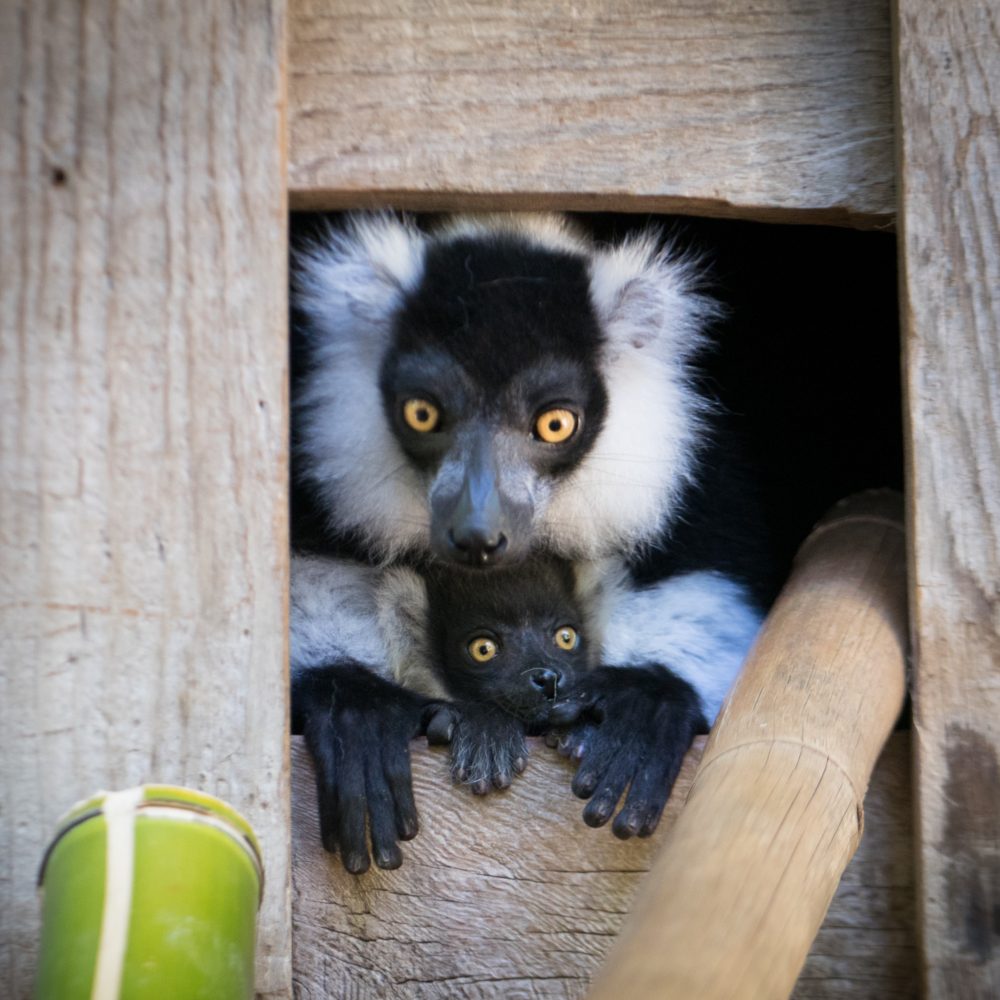
- VisitSupport Happy HollowDONATE TODAYExploreSupport Happy HollowDONATE TODAYLearnSupport Happy HollowDONATE TODAYSupport
-
Today's Hours: 10:00 am to 5:00 pm
Happy Hollow Blog
A new baby at Happy Hollow?
January 21, 2020

Photo of black-and-white ruffed lemurs, Vintana and her baby Loka in 2018. Courtesy of Zookeeper AJ.
It’s that time of year, when black-and-white ruffed lemurs begin their courtship.
The species is classified as critically endangered, and like all species of lemur, black-and-white ruffed lemurs are only found in Madagascar. Of 111 species of lemur in Madagascar, 105 are deemed to be critically endangered, endangered or vulnerable to extinction due to habitat loss, bushmeat hunting and the illegal pet trade.
Happy Hollow, an Association of Zoos and Aquariums accredited facility for over 26 years, participates in Species Survival Plan (SSP) programs. SSP programs help safeguard threatened and endangered species against extinction, improve the managed population’s genetic diversity, and to help teach and inspire the next generation of conservationists.
In 2020, Happy Hollow received a recommendation to allow breeding of a mating pair of black-and-white ruffed lemurs. “There is no indiscriminate breeding at our facility,” says Zoo Manager Kevin Hertell. “We follow the rules and recommendations of our SSP advisors and partners, and every decision is made with the individual animal in mind, as well as the survival of the species as a whole.”
Science has proven that the more genetically diverse a population is, the healthier and more resilient it will be as well, making it easier to adapt to environmental pressures. Hence why it is critical for facilities like Happy Hollow to grow and sustain good genetic diversity in captive populations of lemurs.
Vintana, the zoo’s female and her mate, Nify, have been observed grooming, scent marking and making mating vocalizations – all good indicators that the two are getting ready to take things to the next level. “Our goal is to offer the very best conditions so that mating will occur,” says Veterinary Technician, Rachel Atkins. “Vintana is being closely monitored to track her estrus cycles.”
On average, females commonly give birth to twins or triplets after a 90 to 120 day gestation period.
“It’s really exciting for the staff to be part of this,” says Shannon Heimer, General Manager of Happy Hollow. “It reinforces why we’re here and why we are so committed to our work. The genetics of these black-and-white ruffed lemurs are so valuable and important to the population of this critically endangered species.”
While the zoo team is excited at the prospect of baby lemurs, they are also busy preparing a detailed birthing plan. With any pregnancy – human, lemur, or otherwise, there are always risks to consider.
In 2017, Vintana had her first litter, giving birth to two stillborn babies. In 2018, Vintana gave birth to Loka, a stunning male lemur who still resides at Happy Hollow. But in 2019, after a difficult labor, she gave birth to three more stillborn babies.
In the wild, approximately one out of three lemur babies survive, and approximately 65% fail to make it to 3 months of age. Many babies end up falling out of the nest, but those that survive grow quickly.
With mixed results in her past, the team at the Zoo is preparing for any and all birthing options to increase the likelihood of success for Vintana and her young. Different scenarios include late night birthing, a breech baby, neonatal care, and even being ready to provide an emergency cesarean if there are signs of a difficult labor, or potentially life threatening birth.
For now, Vintana is monitored carefully for signs of pregnancy and to ensure her overall health. While pregnant and while lactating, female ruffed lemurs will often seek higher protein plants to offset the high energy cost of reproduction. At the Zoo, it’s important that Vintana is offered a diet that will satisfy those needs.
“One of the most important things for us to do is make sure that Vintana is comfortable and healthy during her pregnancy,” says Zoo Curator Heather Vrzal. “Using positive reinforcement and choice-based training, our team is working on getting her comfortable enough to willingly participate in ultrasounds when the time comes.”
Is Vintana getting ready to welcome new lemurs into the world?
To be continued…